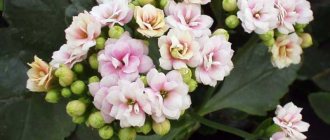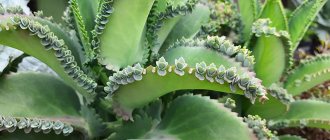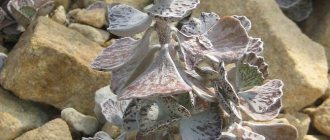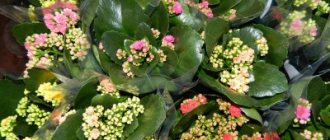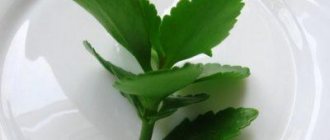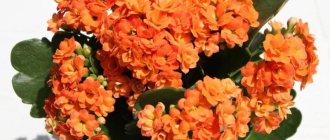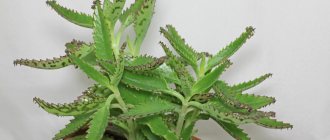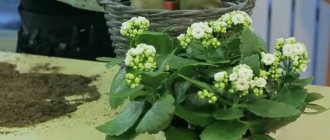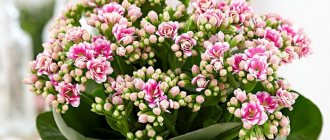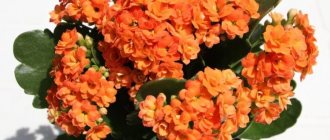Author: Elena N. https://floristics.info/ru/index.php?option=com_contact&view=contact&id=19 Category: Houseplants Published: July 30, 2013Last edits: November 30, 2020
- Kalanchoe bentii / Kalanchoe bentii
Botanical description
Kalanchoe (lat. Kalanchoe) - depending on the species, they can be herbaceous perennials, subshrubs or succulent plants. In total, more than 200 species of Kalanchoe are known, and the genus itself is part of the Tolstyankov family. Natural habitat - tropical zones of Australia, Asia and America. The leaves of different species differ from each other. Usually thick, may be strongly or weakly dissected, may be sessile, or may have a petiole. Red, white, yellow or purple flowers are collected in umbrella-shaped inflorescences. Almost all types of Kalanchoe tolerate growing indoors well. The main thing is to follow the recommendations for caring for Kalanchoe at home.
Briefly about cultivation
- Flowering: within a month from the end of winter.
- Lighting: daylight under bright diffused light should last 12 hours.
- Temperature: in summer – from 18 to 28 ºC, in winter – from 14 to 18 ºC. Lowering the temperature to 10 ºC or lower is unacceptable.
- Watering: through a tray: during the growing season - moderate, as soon as the top layer of the substrate dries, in winter the substrate should dry by a third between waterings.
- Air humidity: normal for residential premises, but in hot weather spraying with warm water is recommended.
- Feeding: in summer and autumn (during budding) - weekly fertilizer for cacti and succulents. Organic fertilizers can be applied no more than twice a month.
- Pruning: After flowering, you need to trim off all flower stalks.
- Dormant period: within 1-1.5 months after flowering.
- Transplantation: at the beginning of active growth, after the roots of the plant fill the pot.
- Substrate: four parts turf soil, two parts leaf and one part each peat and sand. A ready-made substrate for succulents and cacti is also suitable.
- Reproduction: seeds and cuttings.
- Pests: mealybugs, scale insects, spider mites, aphids.
- Diseases: powdery mildew, late blight, gray rot, stem rot, leaf ring spot.
- Properties: Kalanchoe is a medicinal plant with anti-inflammatory, antibacterial, wound-healing, hemostatic and bactericidal effects.
Read more about growing Kalanchoe below.
Diseases and pests
- Gray rot. Gray and sticky coating on the leaves. Appears with irregular watering.
- Late blight rot. Brown coating on leaves. Formed by excessive soil moisture.
- Powdery mildew. White coating on the leaves. The cause is dry air and high temperature.
- Stem rot. Blackening and rotting of the stem. Appears at low plant temperatures.
Diseases are treated by replacing the soil and treating with fungicides. When the stem rots, remove all damaged parts and treat with an antiseptic.
Yellow Kalanchoe is attacked by the following pests:
- Aphids inhibit the growth and flowering of Kalanchoe. For treatment, the plant is washed with warm water and treated with an insecticidal preparation.
- Scale insect - to prevent the disease, cut off all affected areas of the flower, treat the cuts with charcoal, wipe the leaves with an alcohol solution. Then water with fungicide.
- Mealybug - occurs at low temperatures and high humidity. To prevent the appearance of the pest, it is important to comply with the storage conditions of the flower.
Caring for Kalanchoe at home
Lighting
For Kalanchoe at home, the optimal daylight hours are 12 hours. Therefore, the best place for a pot of Kalanchoe from spring to autumn is windows on the east or west side. In winter, it is better to place the flower on a southern windowsill. If daylight hours in winter are very short, then it should be brought to the required level with the help of additional artificial lighting.
Temperature
The Kalanchoe flower feels good indoors at almost any temperature. Within reasonable limits, of course. These limits range from 18 to 28 °C in summer, and from 14 to 18 °C in winter. A decrease in temperature below 10 °C threatens disease and death of Kalanchoe. Low temperature (14-18 °C) promotes bud formation.
Watering Kalanchoe
Homemade Kalanchoe is watered with soft, warm, settled water. Water as the top layer of soil dries, under no circumstances allowing the earthen clod to dry out completely - this leads to a massive fall of Kalanchoe leaves. In winter, water 3-4 days after the substrate dries. Watering can be done through the tray.
- Epiphyllum at home
Spraying
The indoor Kalanchoe plant does not need spraying, but in hot weather this will only have a positive effect on the development of the plant. If the plant is not sprayed, nothing bad will happen. The leaves of the indoor Kalanchoe flower are fleshy, sometimes pubescent, and moisture evaporates weakly.
Top dressing
Kalanchoe needs fertilizer only in the summer, as well as during the budding period in the fall. You can use the same fertilizers that are intended for feeding cacti. In summer, mineral fertilizers are used 4 times a month, and organic fertilizers – 2 times.
Trimming
Since many types of Kalanchoe shed old leaves, these shoots can be trimmed and planted separately or in the same pot. In other species, the shoots overflow the edge of the pot - they can also be trimmed and planted nearby, or they can be left hanging.
Bloom
For good flowering, daylight hours in the spring-autumn period should be no more than 10-12 hours, but the lighting at this time should be very bright. Flowers of some varieties can be cut and placed in a vase, where they can last for several weeks. When indoor Kalanchoe has faded, some of the stems are cut off, giving the plant a beautiful appearance. Do not throw away the cut shoots, but use them for cuttings.
Replanting Kalanchoe
Kalanchoe is replanted only if the plant has grown greatly. Expanded clay or small bricks are poured into the bottom of the pot, which will allow excess water to drain away. Young specimens are planted in a substrate consisting of turf soil, deciduous soil, sand and peat (4: 2: 1: 1). You can use store-bought substrate for succulent plants. For epiphytic Kalanchoe, it would be a good idea to add a little humus to the soil mixture.
Propagation by cuttings
You can root either a piece of the stem or a leaf. All you need to do is separate the leaf from the mother plant in early summer and plant it in nutritious soil. The leaf should be covered with a jar and sprayed from time to time. Soon the leaf will sprout roots.
- Hydrangea paniculata: care
Growing from seeds
Kalanchoe reproduces well by seeds. Sowing of seeds is carried out at the end of winter - beginning of spring in deciduous soil. Sow on the surface, then press down with your finger, without sprinkling soil on top. The container with seeds is covered with glass and paper, ventilated in the morning and evening, and the temperature is not allowed to drop below 16 °C or rise above 20 °C. The earth is regularly watered with warm water, not allowing it to dry out completely. When the first shoots appear, the glass and paper are removed. After 3-4 weeks, the sprouts dive into a larger container. The next transplant is done when the Kalanchoe has 3-4 leaves. Drainage is poured onto the bottom of the pot, and a mixture of peat, turf soil and sand (4:2:1) is placed on top. When the indoor Kalanchoe flower takes root, the top needs to be pinched for better branching. The Kalanchoe is replanted the next time the roots fill the pot. The soil is made up of compost, humus, leafy soil and sand (4:2:1:1). The first flowering can be observed next year.
Different methods of reproduction
Kalanchoe is a plant that reproduces very easily. You can get new flowers in a variety of ways. The process of flower propagation is so simple that anyone can handle it. Plant propagation is carried out by children, seeds, stem and leaf cuttings, and offspring. Any method always gives good results. To propagate Kalanchoe by leaf, you can even use fallen old leaves, which take root incredibly easily.
Some varieties of the plant reproduce by children. Small daughter sprouts form on the leaves of Kalanchoe. Children look very much like adult plants. They have small leaves and roots. Adult succulents most often shed such buds themselves, which easily take root in the mother pot. Later they can be transplanted into another container. If you find formed shoots on the leaves, you can safely break them off and plant them in fertile soil.
Propagation by leaves can be carried out at any time of the year. A cut adult leaf is planted in a pot with a moist substrate. It is covered with a jar or glass on top. The leaf takes root in just a few days. Soon it will become an independent plant. Sometimes part of a leaf is used for propagation. It is buried in the ground and after some time a young plant develops from it.
Kinds
Kalanchoe bentii / Kalanchoe bentii
This Kalanchoe is native to the Arabian Peninsula. The species is represented by powerful subshrubs that grow up to 1 m in height. The leaves are thick and long - almost up to 0.5 m, round in shape, growing in six pairs. White flowers grow on an umbrella-shaped inflorescence. Flowering period mid to late spring. Feels best in cool rooms.
Kalanchoe beharensis / Kalanchoe beharensis
Lives in the south of Madagascar. The species is represented by shrubs. The shoots of this species become bare from below over time. The leaves are covered with hairs; the edge of the leaf can be solid or slightly jagged. The flowers are less than 1 cm long and also pubescent.
- Caring for Citrus Plants
Kalanchoe blossfeldiana
Habitat: Madagascar island. The species is represented by erect, low shrubs - up to 30 cm in height. The leaves are green with red edges, ovoid in shape (length - 7 cm, width - 4 cm), not pubescent. The flowers are red, erect, and collected in umbrella-shaped inflorescences. The usual flowering period is from late winter to early summer. Forms with orange, yellow, white, pink and other flowers have been developed.
Kalanchoe tomentosa
Lives in Madagascar. The species is represented by subshrubs. The shoots are pubescent and erect. The leaves are sessile, elongated-ovate (up to 6 cm long and up to 1.5 cm wide), the edge is smooth. Small flowers grow on an umbrella-shaped inflorescence.
Kalanchoe daigremontiana
Habitat: Madagascar. This species is a herbaceous perennial that grows up to 0.5 m in height. The leaves are variegated from top to bottom. The upper part of the leaf is gray-green, the edges are uneven, not pubescent, elongated-elliptical in shape (up to 10 cm long). The leaves are covered with purple spots. The inflorescence is a panicle. Corolla tube up to 1.5 cm long, petals up to about 5 mm long, pink. Flowering period is winter.
Kalanchoe grandiflora
Also known as Kalanchoe marmorata. This genus is from India, a subshrub slightly more than 0.5 m in height. The leaves are green (may become reddish over time if the flower is in the sun), coarsely toothed. Petioles are short. The flowers are pale yellow, collected in umbrella-shaped inflorescences. The flowering period is May, it smells very nice.
Kalanchoe manginii / Kalanchoe manginii
This is an ampelous species of Kalanchoe that is very similar to Kalanchoe Blossfeld, but differs in having larger flowers that droop rather than being erect. The flowering period usually occurs in spring.
Kalanchoe paniculata / Kalanchoe thyrsiflora
These are tall herbaceous perennials (up to 60 cm tall). The leaves are egg-shaped, tapering towards the base, up to 15 cm long and up to 7 cm wide. The leaves grow densely at the base and the higher they are, the rarer and smaller new silvery-white leaves grow. It blooms at the end of spring with yellow flowers up to 1.5 cm long, petals up to 5 mm in diameter. It reproduces well by children that appear after flowering.
Marbled Kalanchoe / Kalanchoe marmorata
This species has many names and is also known as Kalanchoe grandiflora and Kalanchoe somaliensis. Grows in the mountains of Ethiopia. These are Kalanchoe - half-meter shrubs. The leaves are green (grey over time) covered with lilac or brown spots. The leaf shape is ovoid, but the leaf tapers at the base and has indentations along the edge. White flowers are collected on an umbrella-shaped inflorescence. The corolla tube is up to 8 cm long, the petals have the shape of an elongated egg.
Kalanchoe pinnata / Kalanchoe pinnata
Homeland - Madagascar. Tall herbaceous perennials - reach 1 m in height. The leaves on the same plant are different from each other. The lower leaves are simple, usually ovate with a heart-shaped base, while the lower leaves are pinnate, with three to five leaflets. Leaf color is green. The corolla tube is white-green, and the petals are reddish.
Kalanchoe flammea / Kalanchoe flammea
It can be found under the name Kalanchoe glaucescens. Homeland: Somalia. Low herbaceous perennials that reach a height of 40 cm. The leaves are ovoid, up to 8 cm long and up to 3 cm wide, tapering at the base, widely rounded on the other side, serrated. The flowers are bright red and bright orange, collected in umbrella-shaped inflorescences. The petals are up to 2 cm in diameter, the corolla tube is slightly expanded.
Kalanchoe tubiflora
Originally from Madagascar. This species is a tall subshrub or herbaceous perennial, growing up to 70 cm in height. The leaves are narrow, green with a gray tint and covered with brown spots, reaching up to 12 cm in length. The corolla tube is up to 2.5 cm long, red.
Kalanchoe dissected (lobed) / Kalanchoe laciniata
Herbaceous perennial from Africa. The shoots are fleshy, become bare over time and begin to droop towards the ground. The leaves are serrate, dense and fleshy, strongly dissected, waxy, light green in color. The flowers are yellow-orange, tubular.
Propagation by cuttings
The simplest and most popular way to propagate Kalanchoe is by cuttings. It is relevant at any time of the year. For planting, you can use any twig that accidentally breaks off from the plant. This often happens during the process of flower transplantation. It is necessary to choose strong shoots as cuttings. They can be of any length, but it is worth shortening them to 6-8 centimeters. Typically, the tops of shoots are used for propagation.
They are cut and placed in a jar of water until roots appear, after which the young plants are planted in separate pots. Shoots can also be immediately planted in a moist substrate. They quickly take root in the nutrient mixture. The apical cuttings produce beautiful young plants.


